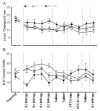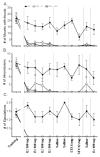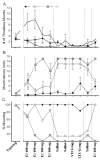Rapid effects of 17β-estradiol on male copulatory behaviors are not elicited by the novel membrane active estrogenic compound STX
- PMID: 23731070
- PMCID: PMC3953449
- DOI: 10.1037/a0032950
Rapid effects of 17β-estradiol on male copulatory behaviors are not elicited by the novel membrane active estrogenic compound STX
Abstract
Estrogens have been shown to rapidly promote male copulatory behaviors with a time-course that suggests rapid signaling events are involved. The present study tested the hypothesis that estrogen acts through a novel Gq protein-coupled membrane estrogen receptor (ER). Thus, either estradiol (E2), STX (a diphenylacrylamide compound that selectively activates a membrane ER pathway), or vehicle were administered acutely to castrated male rats that bore subcutaneous (sc) dihydrotestosterone implants to maintain genital sensitivity. Appetitive (level changes, genital investigation) and consummatory (mounts, intromissions, ejaculations) components of male sexual behavior were measured in a bilevel testing apparatus. Testing showed that E2 treatment promoted olfactory and mounting behaviors, but had no effect on motivation as measured by anticipatory level changes. STX treatment showed no effect on either component of male sexual behavior. These results support previous results that showed that E2 can rapidly affect male sexual behaviors but fail to support a role for the specific membrane-initiated pathway activated by STX.
Figures




Similar articles
-
Hormone replacement with 17β-estradiol plus dihydrotestosterone restores male sexual behavior in rats treated neonatally with clomipramine.Horm Behav. 2014 Nov;66(5):820-7. doi: 10.1016/j.yhbeh.2014.09.014. Epub 2014 Nov 11. Horm Behav. 2014. PMID: 25449595
-
A Novel Membrane Estrogen Receptor Activated by STX Induces Female Sexual Receptivity through an Interaction with mGluR1a.Neuroendocrinology. 2013;97(4):363-8. doi: 10.1159/000351077. Epub 2013 May 22. Neuroendocrinology. 2013. PMID: 23571598 Free PMC article.
-
Sex differences in male-typical copulatory behaviors in response to androgen and estrogen treatment in rats.Neuroendocrinology. 1999 Apr;69(4):290-8. doi: 10.1159/000054430. Neuroendocrinology. 1999. PMID: 10207281
-
The non-aromatizable androgen dihydrotestosterone (DHT) facilitates sexual behavior in ovariectomized female rats primed with estradiol.Psychoneuroendocrinology. 2020 May;115:104606. doi: 10.1016/j.psyneuen.2020.104606. Epub 2020 Feb 7. Psychoneuroendocrinology. 2020. PMID: 32087523
-
Vitamin D modulation of the activity of estrogenic compounds in bone cells in vitro and in vivo.Crit Rev Eukaryot Gene Expr. 2007;17(2):115-47. doi: 10.1615/critreveukargeneexpr.v17.i2.30. Crit Rev Eukaryot Gene Expr. 2007. PMID: 17725484 Review.
Cited by
-
The novel estrogen receptor modulator STX attenuates Amyloid-β neurotoxicity in the 5XFAD mouse model of Alzheimer's disease.Neurobiol Dis. 2022 Nov;174:105888. doi: 10.1016/j.nbd.2022.105888. Epub 2022 Oct 6. Neurobiol Dis. 2022. PMID: 36209948 Free PMC article.
-
The dual action of estrogen hypothesis.Trends Neurosci. 2015 Jul;38(7):408-16. doi: 10.1016/j.tins.2015.05.004. Epub 2015 Jun 15. Trends Neurosci. 2015. PMID: 26089224 Free PMC article. Review.
References
-
- Abdelgadir SE, Resko JA, Ojeda SR, Lephart ED, McPhaul MJ, Roselli CE. Androgens regulate aromatase cytochrome P450 messenger ribonucleic acid in rat brain. Endocrinology. 1994;135:395–401. - PubMed
-
- Attila M, Oksala R, Ågmo A. Sexual incentive motivation in male rats requires both androgens and estrogens. Horm Behav. 2010;58:341–351. - PubMed
-
- Bakker J, Brand T, Van Ophemert J, Slob AK. Hormonal regulation of adult partner preference behavior in neonatally ATD-treated male rats. Behav Neurosci. 1994;56:597–601. - PubMed
-
- Baum MJ. Neuroendocrinology of Male Reproductive Behavior. In: Lajtha A, Blaustein JD, editors. Handbook of Neurochemistry and Molecular Neurobiology Behavioral Neurochemistry, Neuroendocrinology and Molecular Neurobiology. Berlin: Springer-Verlag; 2007. pp. 1–35.
-
- Beach FA. Relative effects of androgen upon mating behavior of male rats subjected to forebrain injury or castrations. J Exp Zool. 1944;97:249–295.
Publication types
MeSH terms
Substances
Grants and funding
LinkOut - more resources
Full Text Sources
Other Literature Sources

